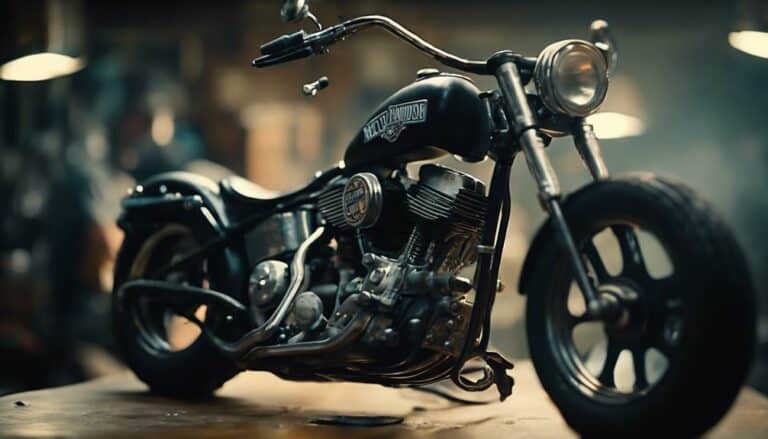When it comes to testing your Harley Davidson single fire coil, you might feel like you're stepping back in time, but fear not, the process is straightforward.
By following a few simple steps, you can guarantee your bike's ignition system is in top shape.
From checking resistance to inspecting for physical damage, each step plays a crucial role in maintaining your bike's performance.
Stay tuned to uncover the essential tips for testing your single fire coil and keeping your Harley running smoothly.
Key Takeaways
- Use a multimeter to measure resistance between leads for accurate diagnosis.
- Look for physical damage like cracks or burns during inspection.
- Check connections for corrosion and ensure tight reinstallation for best performance.
- Regularly test and monitor coil resistance to prevent potential issues.
Tools Needed
To properly test a Harley Davidson single fire coil, you'll require a multimeter as the primary tool for accurate diagnostics. When checking the coil, make sure you have a multimeter that can measure resistance in ohms. This will make certain that you get precise readings which are important for identifying any potential issues with the coil's resistance.
By using a multimeter, you're going to have a reliable tool that assists in troubleshooting and maintaining the single fire coil in your Harley Davidson motorcycle. The multimeter plays an essential role in diagnosing the health of the coil, allowing you to pinpoint any resistance irregularities that may be affecting the performance of your motorcycle.
Checking Coil Resistance
When moving on to checking the coil resistance of your Harley Davidson single fire coil, start by measuring the resistance between the middle and outside leads of the coil. This step is critical in diagnosing any potential issues with the coil.
Repeat the resistance measurement for the other side of the coil to guarantee consistency. Uneven resistance readings on either side may indicate a faulty single fire coil, requiring further inspection.
Troubleshooting tips suggest that single fire coils need specific testing for each side to guarantee proper functionality. Maintenance recommendations include regular checks of the coil resistance to prevent any unexpected breakdowns or engine malfunctions.
Common issues related to coil resistance may include fluctuations in readings or sudden drops in resistance levels, indicating a problem that needs immediate attention. Accurate testing of single fire coils is paramount for maintaining peak performance and avoiding potential engine troubles down the road.
Testing for Continuity
For effective testing of continuity in your Harley Davidson single fire coil, make sure you measure the resistance between the middle and outside leads on both sides using a multimeter set to the lowest ohm setting. Single fire coils require specific testing for each side to make certain proper functioning. By following these troubleshooting techniques, you can diagnose any issues affecting the ignition system of your Harley Davidson motorcycle accurately.
To assist you further in understanding the importance of testing for continuity, refer to the table below:
| Side | Resistance Reading | Condition |
|---|---|---|
| Left Side | 3.5 ohms | Normal |
| Right Side | 4.2 ohms | Normal |
Inspecting for Physical Damage
After ensuring the continuity of your Harley Davidson single fire coil, proceed to carefully inspect the exterior for any visible physical damage. Here are some key steps to follow during this damage assessment:
- Visual Inspection: Look for cracks, burns, or any other visible damage on the coil's exterior. Pay close attention to the connections for signs of corrosion, loose wires, or arcing that could affect performance.
- Maintenance Practices: Check for melted or discolored areas on the coil, as these may indicate overheating issues. Ensure there's no oil or debris buildup around the coil, which could impact its functionality.
- Repair Considerations: If you find any physical damage during the inspection, consider replacing the single fire coil to prevent potential issues down the road.
- Safety Precautions: Remember to take necessary safety precautions while handling the coil and inspecting for damage to avoid any mishaps.
Reinstallation and Final Checks
Securely reinstalling the tested single fire coil back in its original position on the bike is important for ensuring the best performance. When mounting the coil, make sure to follow proper mounting techniques to prevent any vibrations or movement while riding. Check that all connections are secure and tight to avoid any electrical issues during operation. After reinstalling, troubleshoot by conducting a thorough inspection to ensure everything is in place. Double-check the coil's resistance readings to confirm they fall within the specified ranges, guaranteeing optimal performance. Before starting the engine, review all security measures and operational guidelines to prevent any mishaps. Once everything is in order, evaluate the performance of the bike's ignition system to verify that the coil is functioning correctly post-reinstallation. Finally, conduct a test ride to assess the bike's overall performance and ensure there are no issues related to the coil.
| Mounting Techniques | Troubleshooting Tips | Performance Evaluation | Maintenance Practices | Security Measures |
|---|---|---|---|---|
| Follow proper techniques to secure coil | Conduct thorough inspection post-reinstallation | Evaluate ignition system performance | Double-check resistance readings | Review all security measures |
Conclusion
In summary, testing a Harley Davidson single fire coil is essential for maintaining peak performance and preventing potential issues. By using a multimeter to check resistance and continuity, you can make sure the coil is functioning properly.
Remember, a faulty coil can lead to starting problems, rough running, and loss of power. So, don't overlook this critical step in maintaining your bike's health and performance.
Just like a well-tuned engine, a properly tested coil is the key to a smooth ride.

